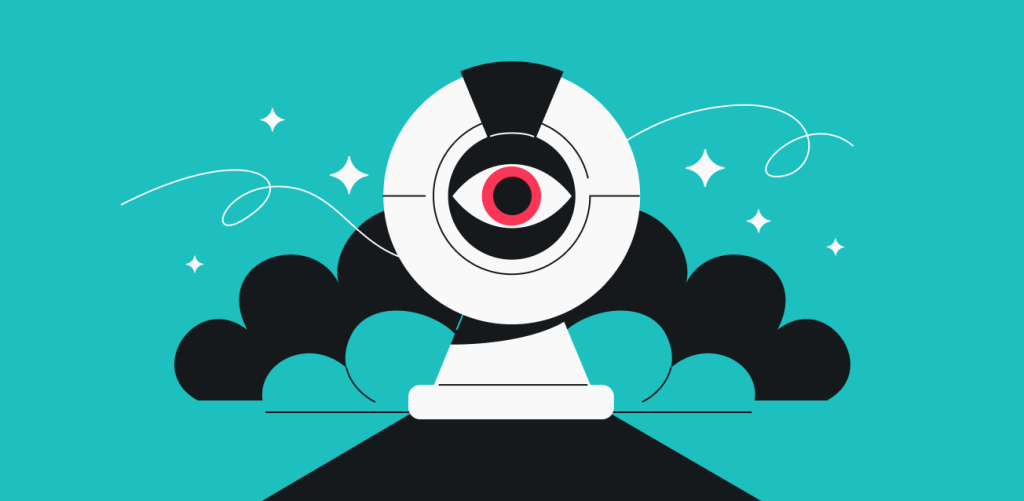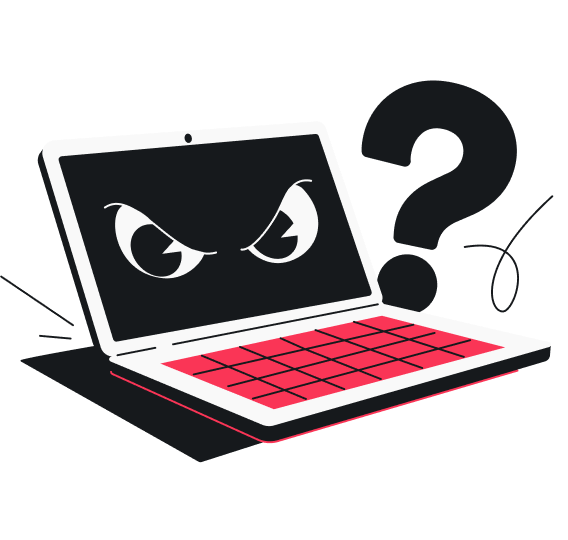
Modern times pose modern threats, and hacked webcams are a real danger in our everyday lives. Unfortunately, your webcam is not a hard nut for bad actors to crack, meaning the chances of your webcam getting hacked within your lifetime are pretty high.
Also commonly referred to as camfecting, webcam hacking is a process of remotely accessing a camera. Hackers achieve this by distributing malware through phishing attacks.
Feel like your webcam has been hacked? Follow the steps below and find out.
Table of contents
7 ways of checking if your webcam is hacked
It’s as clear as day that there are criminals recording video footage, so let me show you how to spot a webcam hacker in your system.
-
Check your network traffic
If someone is using your webcam to spy on you, they will have to send this data via your home router. If you log in to your router (this skill may become useful if you ever decide to put a VPN on your router) you can see the rate at which it sends and receives data. Close all your apps and browser windows so you are not using any data. If there is still a lot passing over the network, someone has compromised your computer.
This might not be due to your webcam, of course. You could be part of a botnet or have been compromised differently. But it’s a sign of something suspicious happening in the background.
-
Check your webcam indicator light
Most webcams come with an indicator light, even those integrated into laptops. This light turns on whenever the webcam is working, and responsible manufacturers try to code the controls for this light at the lowest possible hardware level.
With a quality webcam, it’s pretty hard for an attacker to spy on you without this light turning on. So if the camera light is on and it shouldn’t be, there’s a good chance you’ve been the victim of a hack.
-
Check your file system
Most webcam hackers rely on the limited knowledge of the average user. As a result, a lot of people who hack webcams don’t even try to hide their activities. Find out where your webcam recordings folder is and check it. Look out for strange storage files — if you see videos you didn’t record, you’ve probably been hacked.
-
Look for suspicious applications
Malware requires resources to run, so you can distinguish malware by looking at the active processes. Before doing so, you should reboot your computer and open the Task Manager (Activity Monitor for MacOS users).
Normally, no app should use a lot of resources right after a reboot. If you see a process running and eating away at computer resources, it’s likely to be malware.

-
Check your browser extensions
Some malware comes in the form of a browser extension rather than a malicious app. Therefore, checking the task manager won’t do any good in finding it. If your webcam indicator light turns on when you open your browser, you’re likely dealing with a malicious browser extension.
First, delete any extensions you don’t use or remember adding. If the problem persists, turn extensions off one by one. When the indicator light switches off, you’ve found your problem.
-
Scan for malware
Another way to detect and get rid of malware is to run regular malware scans. There are plenty of tools available for this, and a good malware scanner should catch most instances of malware that can be used to spy on you.
Just make sure you keep your security software up to date because new zero-day vulnerabilities appear every week, and your software needs to know what it is looking for.
-
Check your security settings
Another tell-tale sign that your webcam has been hacked is if its security settings are a bit screwy. Open the settings on your webcam and take a look.
If you cannot change these settings or the name of the admin account has been changed, you’ve probably been compromised. If this happens, there is not much you can do about it; other than getting a new webcam and making sure you change the default password as soon as it arrives.
How to protect your webcam from hackers
Practicing precaution is the best thing you can do to avoid hackers. Regardless if your webcam has been hacked and you’re looking to avoid future issues or just trying to make sure you never get them in the first place.
Here are some things you can do to protect yourself from webcam hackers:
- Use an antivirus — a good antivirus will warn you of potential malware before it gets to your device. On top of that, Surfshark Antivirus has a webcam protection feature, so you can be sure no one is spying on you;
- Don’t click suspicious links — camfecting malware usually spreads through phishing attacks, so don’t click any links unless you are 100% sure they’re legitimate;
- Use a VPN — a VPN does a lot more than just change your IP. A premium VPN service drastically improves your online safety. Consider getting one, especially if you frequently use public Wi-Fi;
- Enable your firewall — enabling security features is generally a good tip for staying safe online. A firewall monitors your traffic and warns you if anything seems off. Keep it enabled unless you have a good reason not to.
If it’s a problem for Zuckerberg…
Covering your webcam won’t protect you from hackers, but it won’t let them see a thing. If you are worried that someone is using your webcam to spy on you, you are not alone. A couple of years back, a picture of Mark Zuckerberg appeared, showing his laptop in the background. Over the webcam, he had stuck a small piece of tape.
The picture caused a lot of debate at the time: here was the boss of a huge tech company, who presumably has some of the best tech support in the world backing up his own not inconsequential knowledge, worried about hackers getting into his webcam.
It wasn’t just Zuck, either. During the following weeks, the FBI director, James Comey, told reporters, “I put a piece of tape over the camera because I saw somebody smarter than I am had a piece of tape over their camera.”
Bottom line: your online safety is up to you
There are malicious people on the web looking for victims to extort. They’re going to do their dead-level best to record what you’re up to. For their profit — at your expense.
If you have any suspicion about your webcam acting up, take action. Check your traffic and files, look for suspicious apps and extensions, run frequent malware scans, and always keep your eye on the webcam indicator light. It may take some effort, but it’s a fair trade-off for not having cybercriminals watching over you.
FAQ
What are the two dots next to the camera on my laptop?
Generally speaking, one dot is an indicator light, and the other is the microphone, but the nuances depend on the laptop. Some computers come with instructions — you can check them there as well.
Can a laptop camera be on without a light?
If the LED light is software-managed — yes. If the LED is hardwired to the camera — no (unless you rip out the wiring or damage the circuitry).
How do I know if my webcam is on?
Usually, the indicator LED turns on when the camera is on. Unless you turned it on by yourself — you got hacked. So, you should check if there is any malware running in the background that’s responsible for the monitoring.
Can someone see me through my camera?
Yes, others can potentially see you through your camera IF your device gets hacked. Whether it’s a webcam, a smartphone, or a Ring doorbell hack, attackers can watch, record, and misuse your private moments if they gain access to your device.
Can you hack through the webcam?
Yes, it’s called camfecting. And they do it via Remote Access Trojans (RATs) — a type of malware that lets the attacker manipulate and use the victim’s device remotely.
Can webcams still be hacked?
Yes, webcams can still get hacked in 2024. While there are plenty of advances in cybersecurity, hackers keep improving as well, and hacked webcams are still a real issue.

